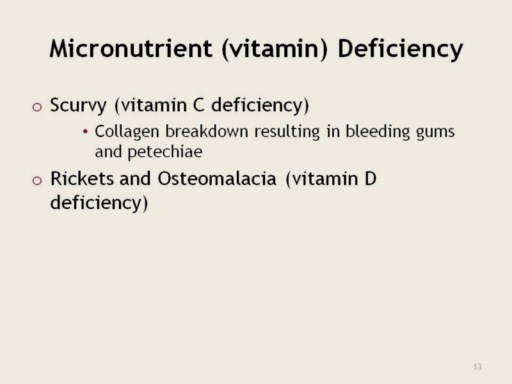| front |1 |2 |3 |4 |5 |6 |7 |8 |9 |10 |11 |12 |13 |14 |15 |16 |17 |18 |19 |20 |21 |22 |23 |24 |25 |26 |27 |28 |29 |30 |31 |32 |33 |34 |review |
 |
Scurvy is easily prevented with a small amount of vitamin C (10 mg per day; 1 medium-sized tomato has approx. 16 mg of vitamin C; 6 ounces of orange juice has approx. 70 mg of vitamin C). However, it is still seen though in populations consuming very restrictive diets.
Rickets (in children) and osteomalacia (in adults) occurs in times of insufficient vitamin D, resulting in improper bone mineralization. Vitamin D deficiency can also cause muscle weakness and pain. Vitamin D deficiency is most likely to occur in populations living in latitudes above 40 degrees north, or below 40 degrees south, exclusively breastfed infants, obese individuals, people who wear sunscreen or cover their skin whenever outside, dark skinned individuals, and the elderly. Sub-clinical deficiency (no overt osteomalacia present), which may result in insulin resistance, autoimmune diseases, hypertension and possible cancer, is now believed to be a more common problem than previously thought.
Bandeira F, Griz L, Dreyer P, et al. Vitamin D deficiency: A global perspective. Arq Bras Endocrinol Metabol. 2006 Aug;50(4):640-6. http://www.scielo.br/scielo.php?script=sci_arttext&pid=S0004-27302006000400009&lng=en&nrm=iso&tlng=en
Kanekar A, Sharma M, Joshi VR. Vitamin D Deficiency—A Clinical Spectrum: Is There a Symptomatic Nonosteomalacic State? Int J Endocrinol. 2010; 2010: 521457. http://www.ncbi.nlm.nih.gov/pmc/articles/PMC2778352/?tool=pubmed |